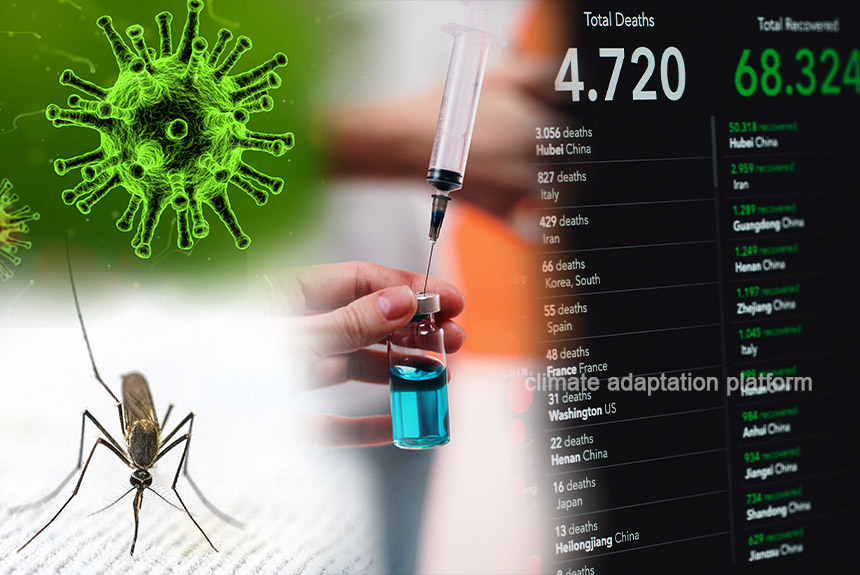As the planet warms, it is causing changes in precipitation, increasing precipitation in some areas and drought in others. Changes in the local climate are often associated with vector-borne disease rates.
The New England Journal of Medicine review article states that “warming temperatures affect the behaviour, physiologic characteristics, and life history of vectors and pathogens as well as the abundance and behaviour of reservoir hosts and definitive hosts. The interactions among temperature, vector, and pathogen can change the risk of spreading human-to-human disease and spillover to humans from reservoir hosts.”
The article notes the Intergovernmental Panel on Climate Change (IPCC) has “reported with high confidence that the prevalence of vectorborne diseases has increased in recent decades and that the prevalences of malaria, dengue, Lyme disease, and West Nile virus infection, in particular, are expected to further increase during the next 80 years if measures are not taken to adapt and strengthen control strategies.”
In 2020, Malaria caused 600,000 deaths in Africa despite control efforts, and temperature increases of 0.2°C per decade caused Malaria to spread in higher elevations in Columbia and Ethiopia. The article says that Lyme disease, a tickborne illness, is most prevalent in regions with the most elevated temperatures in central and western Europe and East Asia.
According to the study, people in less developed countries are more susceptible to vector-borne diseases, and this vulnerability will further widen health inequities as poorer countries have limited access to healthcare and suffer from inadequate housing and poor environmental conditions. It will also hamper their socio-economic development.
Investments in surveillance, climate-informed early-warming systems, and the use of vaccines will form climate adaptation strategies that have improved public awareness, detection, prevention, and treatment of vector-borne diseases. Vaccines have also successfully prevented three vector-borne diseases: yellow fever, Japanese encephalitis, and tick-borne encephalitis.
As the climate continues to warm, vectors are expanding their latitude and altitude ranges and length of season that they are active, which will have significant implications for the health sector worldwide.
Investments in technologies and innovations are needed to control the spread of vectors, including vaccines, and these solutions should be tailored to local and rapidly emerging situations. The article notes that these adaptation measures must go hand in hand with the “urgent mitigation efforts to keep average temperatures below critical thresholds.”
Extreme weather events are becoming common due to climate change. Climate change is creating extreme heatwaves, floods, coldwaves and droughts associated with increasing disease incidences. The link between severe weather and disease burdens has led to the conception of so-called climate-sensitive diseases.
A study published in The Lancet on June 2023 analysed the association between weather conditions and cause-specific deaths over 16 years in Nouna, Burkina Faso, from 1 January 2000 to 31 December 2015, to assess associations between weather conditions (maximum temperature and total precipitation) and deaths attributed to specific climate-sensitive diseases. They found that of 8256 total deaths in the Centre de Recherche en Santé de Nouna (CRSN) demographic surveillance area, 6185 (74·9%) were caused by climate-sensitive diseases over the observation period.
As the planet continues warming, climate-sensitive diseases like Malaria, diarrhoeal diseases, and non-communicable diseases of the respiratory and cardiovascular systems are expected to increase and shift in some areas.
The study demonstrates that “extreme heat and low precipitation are associated with excess risk of death from particular climate-sensitive communicable and non-communicable diseases. These findings support existing evidence and highlight emerging potential health risks posed by the effects of climate change on populations in the Sahel and similar regions globally.”
“The results of this study provide motivation for the expansion of routine data systems to monitor climate effects on health and for developing and implementing climate preparedness programmes for vulnerable communities in the Sahel region.”
Sources:
Thompson, M., & Stanberry, L., (2022 November 24). Climate Change and Vectorborne Diseases. The New England Journal of Medicine. Retrieved from https://www.nejm.org/doi/full/10.1056/NEJMra2200092
Arisco, N. J., Sewe, M. O., Bärnighausen, T., Sié, A., Zabre, P., & Bunker, A.. (2023). The effect of extreme temperature and precipitation on cause-specific deaths in rural Burkina Faso: a longitudinal study. The Lancet Planetary Health, 7(6), e478–e489. https://doi.org/10.1016/s2542-5196(23)00027-x



Leave a Reply